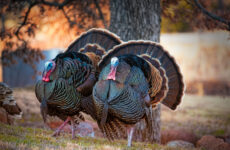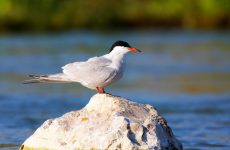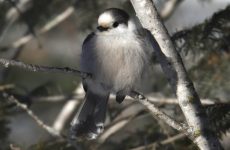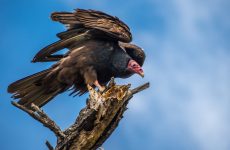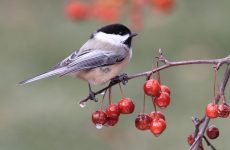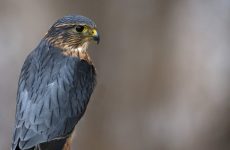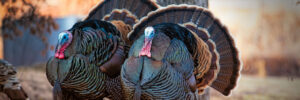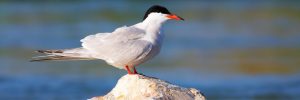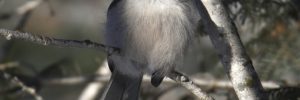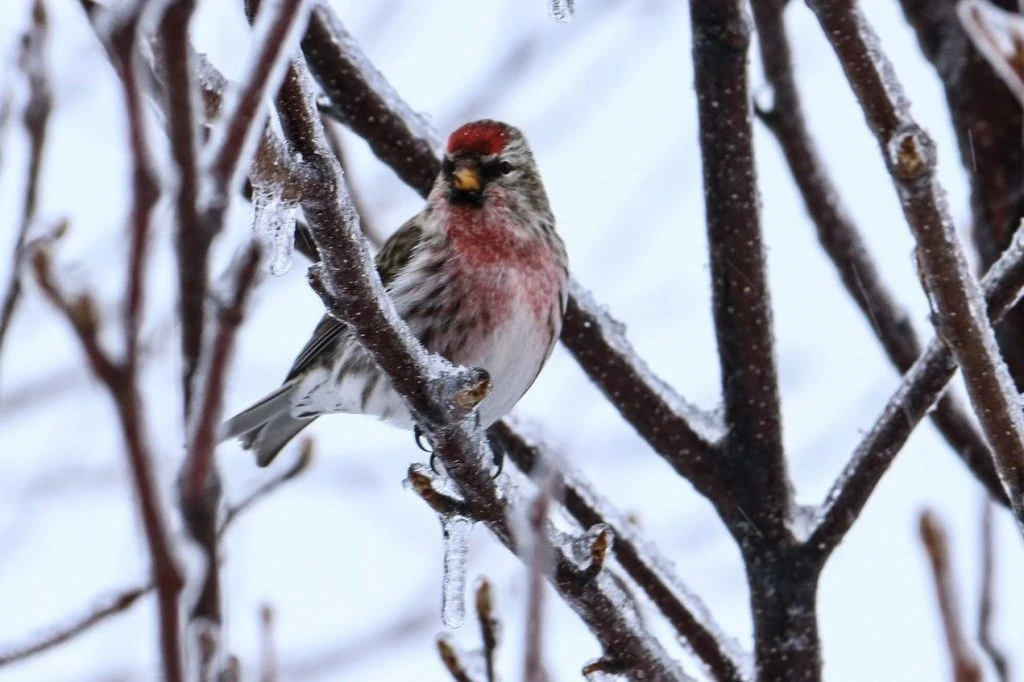
Ten species of finches are recognized as regularly occurring in Ontario, plus an additional four accidental species. This guide will help you identify them with photos, song recordings, and when and where to spot them.
- Finches in Ontario all year: American Goldfinch, House Finch, Pine Siskin, White-winged Crossbill
- Finches in Ontario in summer: Purple Finch
- Finches in Ontario in winter: Common Redpoll, Evening Grosbeak, Pine Grosbeak, Hoary Redpoll, Red Crossbill
- Accidental Finches in Ontario: Brambling, Gray-crowned Rosy-Finch, Cassin’s Finch, Lesser Goldfinch
Finches are small to medium-sized songbirds with conical bills suitable for breaking seeds and nuts. They have round, compact bodies, notched tails, and relatively pointed wings.
Despite their size, they’re often easy to spot because of their bright yellow and red colors, mostly in males. Females are less colorful than males and blend into their surroundings, and are more green and brown in color.
There are 240 species of True Finches belonging to the Fringillidae family found worldwide, except for the polar regions. They are called ‘True Finches’ as birds from other families may also be called finches, but they are not officially finches. The finch family also includes redpolls, siskins and some grosbeaks.
Finches love to eat seeds, and they have strong bills that are perfect for cracking them open. However, insects are usually fed to their young because they still can’t crack seeds open on their own.
Finches are highly sociable birds that can often be heard before they are seen as they chatter away in their groups. They don’t necessarily all have a melodious song, but some certainly do, so check them out for yourself.
Nests of finches are simple constructions in trees and shrubs, made from twigs and other woven material and lined with softer material.
A group of Finches is called a “charm”. Maybe that’s also why many finches are caged birds because of their musical voice and their bright colors.
Finches are sadly in decline due to habitat loss, window collisions, pesticide use, and cats. Some are now on Red Lists, but you can help by keeping cats indoors, not using pesticides, and providing natural habitats.
If you want to attract Finches to your backyard, provide them with tube feeders filled with sunflower seeds, a water source that does not freeze, and a place for them to nest. You can also use these free bird ID charts for Ontario to help identify many of the birds that visit your backyard.
This guide will help you identify the types of finches spotted in Ontario according to avibase. The birds in this list are ordered by how frequently they are spotted, from most frequent to least frequent, according to bird watchers’ checklists submitted to ebird.
14 Species of Finches in Ontario:
1. American Goldfinch
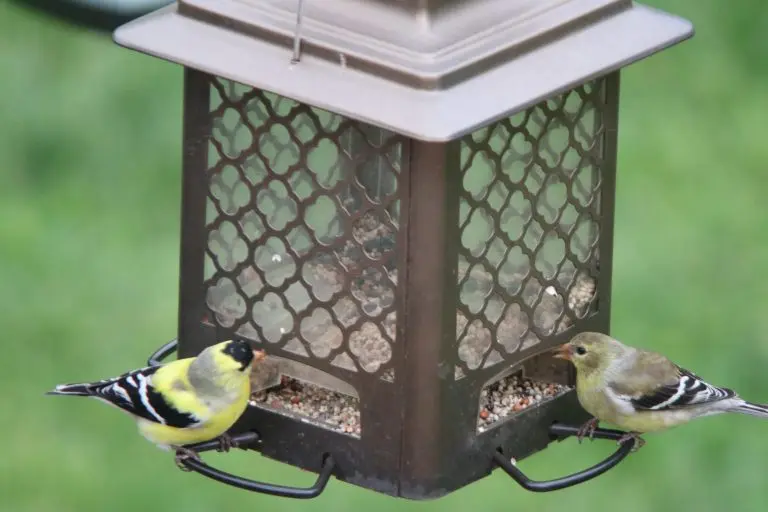
American Goldfinches are spotted all year in southern Ontario, but their numbers increase during the breeding season. They are recorded in 44% of summer checklists and 27% of winter checklists submitted by bird watchers for the province.
American Goldfinches are popular birds. The males have bright yellow and black coloring in spring. The females are duller brown, as are males in winter.
- Spinus tristis
- Length: 4.3-5.1 in (11-13 cm)
- Weight: 0.4-0.7 oz (11-20 g)
- Wingspan: 7.5-8.7 in (19-22 cm)
American Goldfinches can be found in most of North America and are usually resident all year. However, those that breed in Canada and the Midwest migrate to the southern US States for winter.
You can find American Goldfinch in weedy fields and overgrown areas foraging for sunflower, thistle, and aster plants. They are also common in suburbs, parks, and backyards.
American Goldfinch Song:
Nests of American Goldfinches are usually located in saplings or shrubs. They are made of grass, bark strips, and feathers on which the female lays four to six eggs. It takes ten to twelve days for the eggs to hatch, and while the male feeds the female, she incubates the eggs.
Attract American Goldfinches to your backyard by planting thistles and milkweed. They will visit most bird feeders and prefer sunflower seed and nyjer seed.
Fun Fact: Brown-headed Cowbirds are known for laying eggs in an American Goldfinch nest, but unfortunately, the seed-based diet that the parents feed them is unsuitable for them, and they eventually die.
2. House Finch
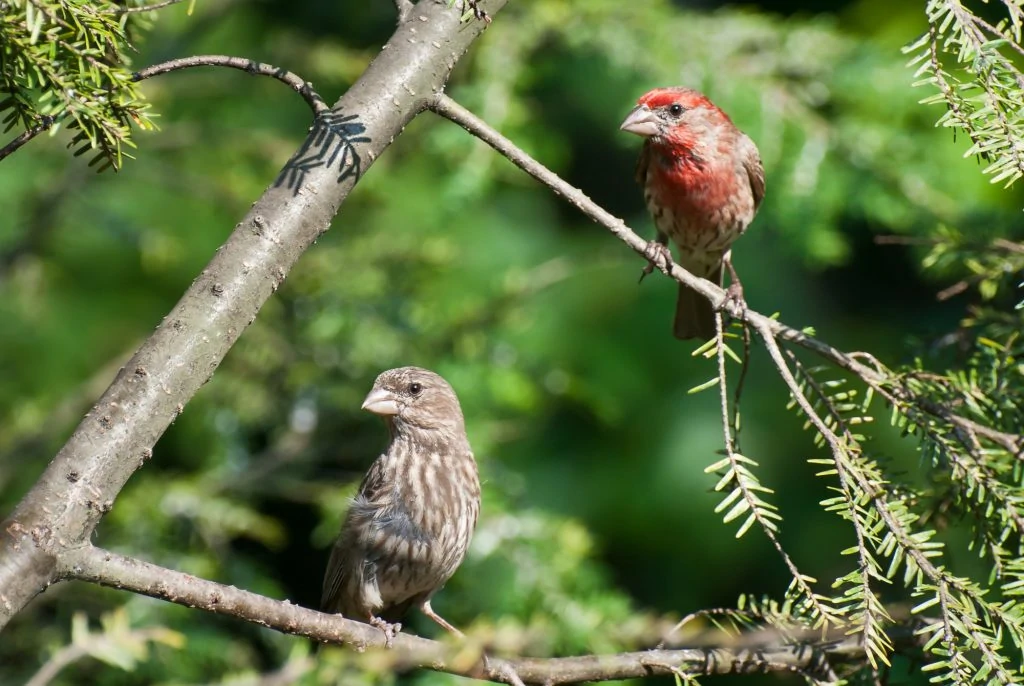
House Finches are introduced species in Ontario, and they are resident here all year. They do not migrate and appear in 8% of summer checklists and 12% of winter checklists submitted by bird watchers for the province.
House Finch males have a red head and breast, and the rest of their bodies are mainly brown-streaked. Females are brown-streaked all over.
- Haemorhous mexicanus
- Length: 5.1-5.5 in (13-14 cm)
- Weight: 0.6-0.9 oz (16-27 g)
- Wingspan: 7.9-9.8 in (20-25 cm)
Originally only in western US states, House Finches were introduced to eastern US states and have done very well, even pushing out the Purple Finch.
You can find House Finches in parks, farms, forest edges, and backyard feeders in noisy groups that are hard to miss. They feed on seeds, fruit, and buds.
House Finch Song:
House Finch Call:
Nests of House Finches are commonly found in thickets, bushes, natural, hollow cavities, or even in buildings. The female builds them using grass, leaves, twigs, and feathers. There can be two to six eggs at a time that take as much as two weeks to hatch.
Attract House Finches to backyard feeders with black oil sunflower seeds, millet, and milo or nyjer seeds in tube feeders or platform feeders.
Fun Fact: House Finches were brought to Long Island as caged birds. When they were released into the wild, they flourished and spread to the eastern United States.
3. Purple Finch
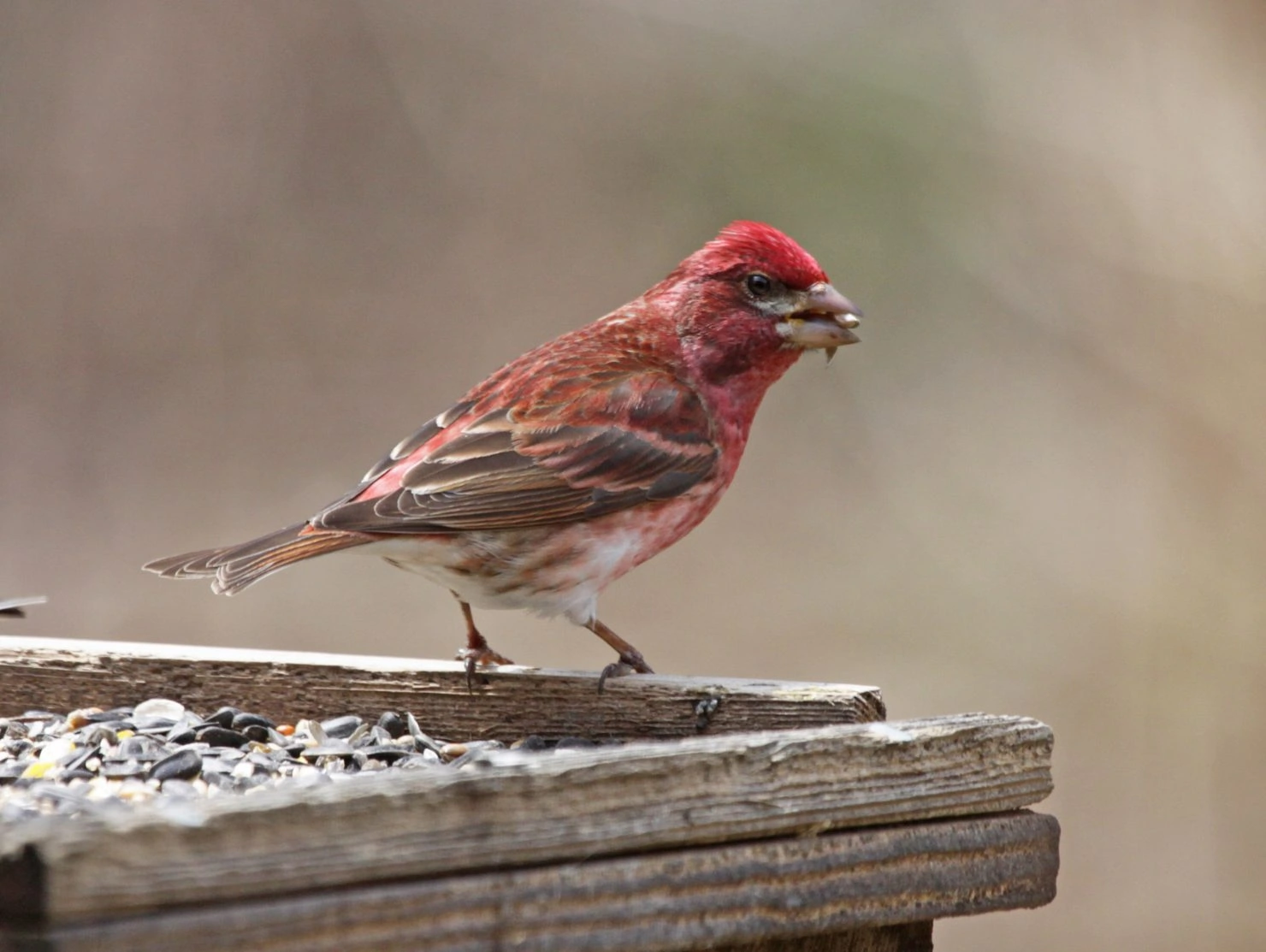
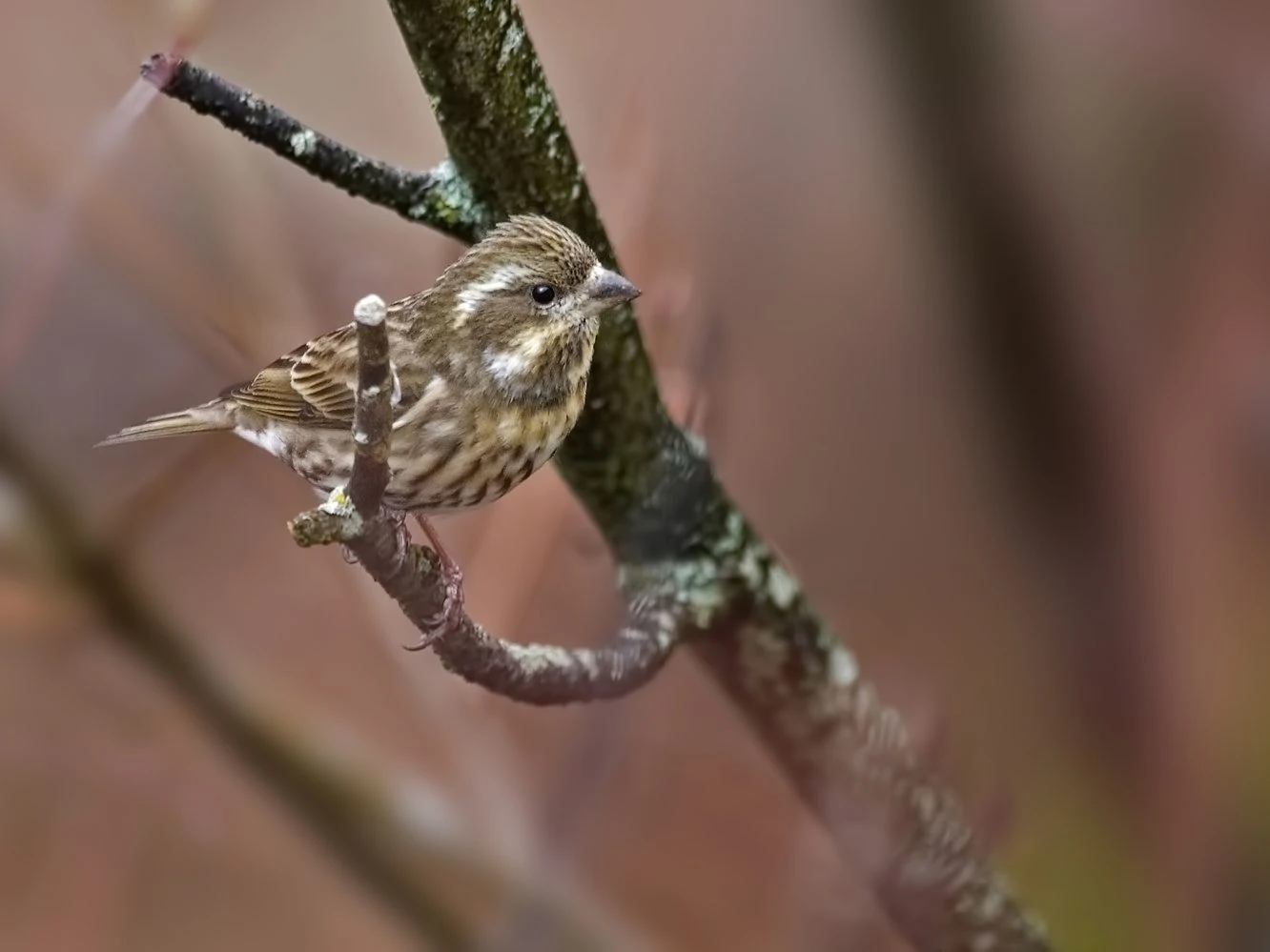
Purple Finches are seen in Ontario during the breeding season and are mainly spotted from April to October. However, some do remain here all year. They are recorded in 6% of summer checklists and 2% of winter checklists.
Purple Finches males have reddish-purple heads and breasts with more brown on the back and wings, and they have a paler belly. Females are brown-streaked all over. They look very similar to House Finch but are redder, especially at the top of their back.
- Haemorhous purpureus
- Length: 4.7-6.3 in (12-16 cm)
- Weight: 0.6-1.1 oz (18-32 g)
- Wingspan: 8.7-10.2 in (22-26 cm)
Purple Finches breed in Canada and overwinter in eastern states but can be found all year in the north-east and Pacific coast.
You can find Purple Finch in evergreen forests feeding on seeds but also buds, nectar, and berries.
Purple Finch Song:
Nests of Purple Finches are located high up in trees. They are made of twigs, barks, weeds, and moss. They usually hold three to five eggs that are incubated for thirteen days by the female.
Attract Purple Finches to your backyards with black oil sunflower seeds.
Fun Fact: Purple Finches are the state bird of New Hampshire.
4. Common Redpoll
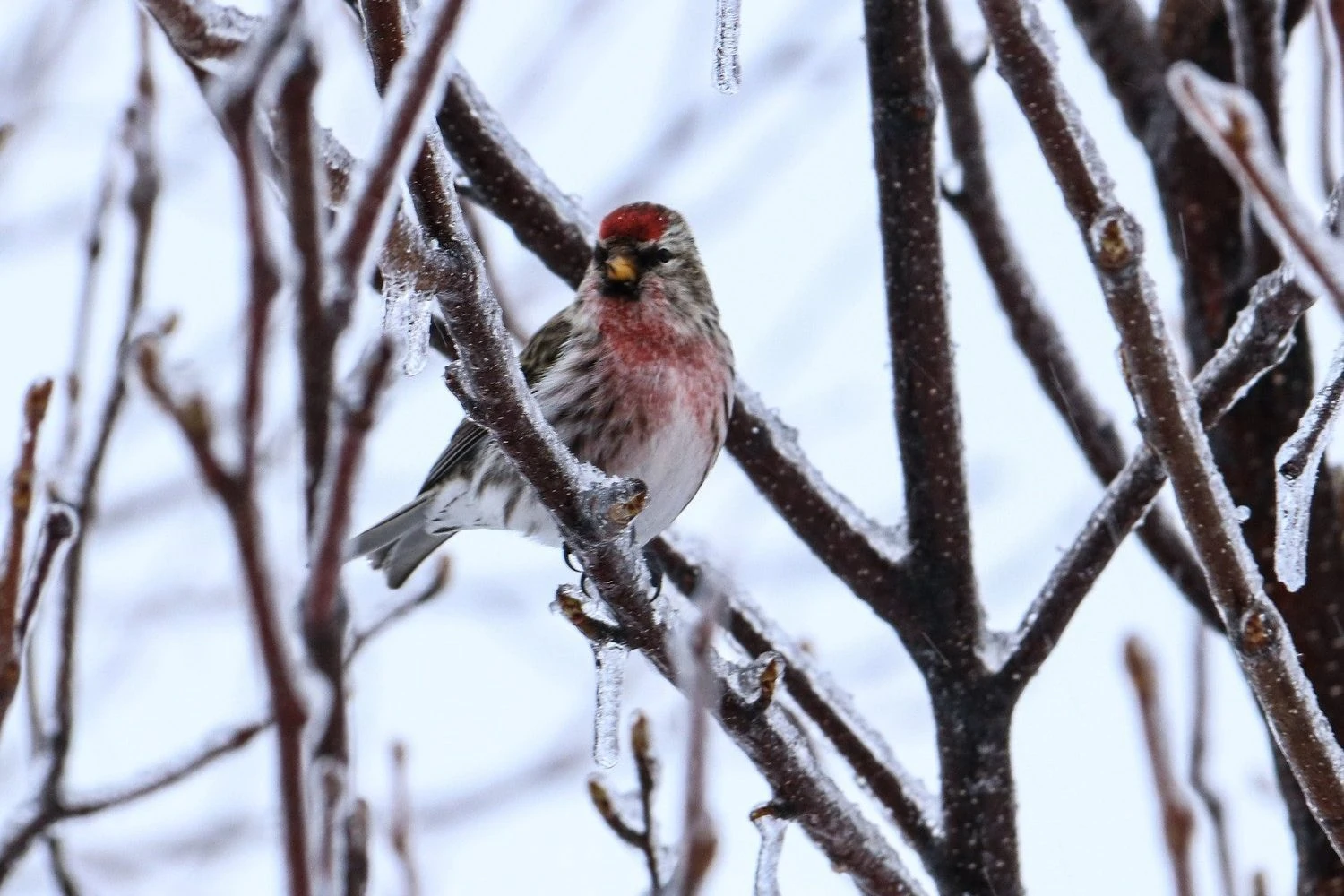
Common Redpolls are more frequently spotted in Ontario during winter, from October to April, but some spend the breeding season in the north of the province. They appear in 8% of winter checklists.
Common Redpolls are small and have red foreheads and are brown and white streaked over the rest of their bodies. Males also have pink breasts, but females do not. They have small bills for finch and a short notched tail.
- Acanthis flammea
- Length: 4.7-5.5 in (12-14 cm)
- Weight: 0.4-0.7 oz (11-20 g)
- Wingspan: 7.5-8.7 in (19-22 cm)
Common Redpolls breed in artic in Canada and spend the winter in the rest of Canada and northern US states and less frequently in central US states.
In winter, they will sometimes tunnel into the snow to stay warm during the night. They can eat up to 42% of their body mass every day and can store up to 2 grams of seeds in a stretchy park of their esophagus.
You can find Common Redpolls in weedy fields or feeding on catkins in trees, but they will also come to feeders for small seeds such as nyjer seeds or thistle.
Common Redpoll Song:
Nests of Common Redpolls are hidden in rock crevices or in dense, low shrubs. To keep the nests and the eggs warm, they are usually built out of moss, feathers, plant material, and animal hair. The female lays four to seven eggs that she incubates for about eleven days. Even after they hatch, the young still stay in the nest and are cared for by their mothers for two more weeks.
Attract Common Redpolls to your backyard by feeding them nyjer seeds and shelled sunflower seeds.
Fun Fact: Common Redpolls can survive temperatures of -65 Fahrenheit without freezing to death. They add around 30% more feathers to stay warm.
5. Pine Siskin
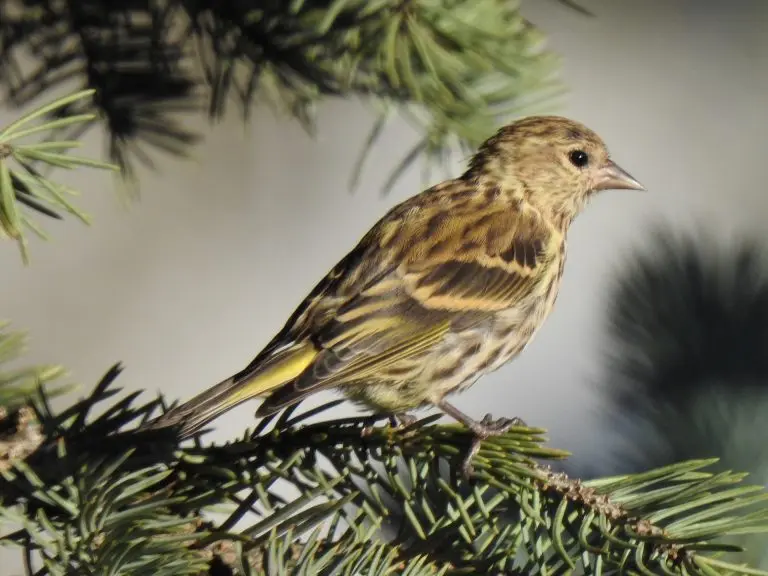
Pine Siskins spend the breeding season in Ontario, but their numbers increase during the spring and fall migration from February to April and again from October to November. They can also be seen here all year in the south of the province.
They appear in around 3% of summer and winter checklists and up to 7% of checklists during migrations.
Pine Siskins are small brown finches with yellow streaks on the wing and tail. They have a forked tail and pointed wings, with a short pointed bill.
- Spinus Pinus
- Length: 4.3-5.5 in (11-14 cm)
- Weight: 0.4-0.6 oz (12-18 g)
- Wingspan: 7.1-8.7 in (18-22 cm)
Pine Siskins remain all year in the pine forests in the western states and along the Canadian Border. Some also breed in Canada before heading south for winter.
Depending on pine cone crops, they can be found over much of North America. As their name suggests, Pine Siskins predominantly eat seeds from conifers, but they also eat young buds and seeds from grasses and weeds.
Pine Siskin Song:
Nests of Pine Siskins are built ten to fifty feet high above the ground, away from the tree trunk. They are usually made of twigs, barks, and moss and are home to three to five eggs. It takes about thirteen days for the eggs to hatch.
Attract Pine Siskins to your backyards with thistle and nyjer feeders but also black oil sunflower seeds and suet.
Fun Fact: The name “Siskin” comes from the Pine Siskin’s chirp. So, it’s basically a “pine chirper.”
6. Evening Grosbeak
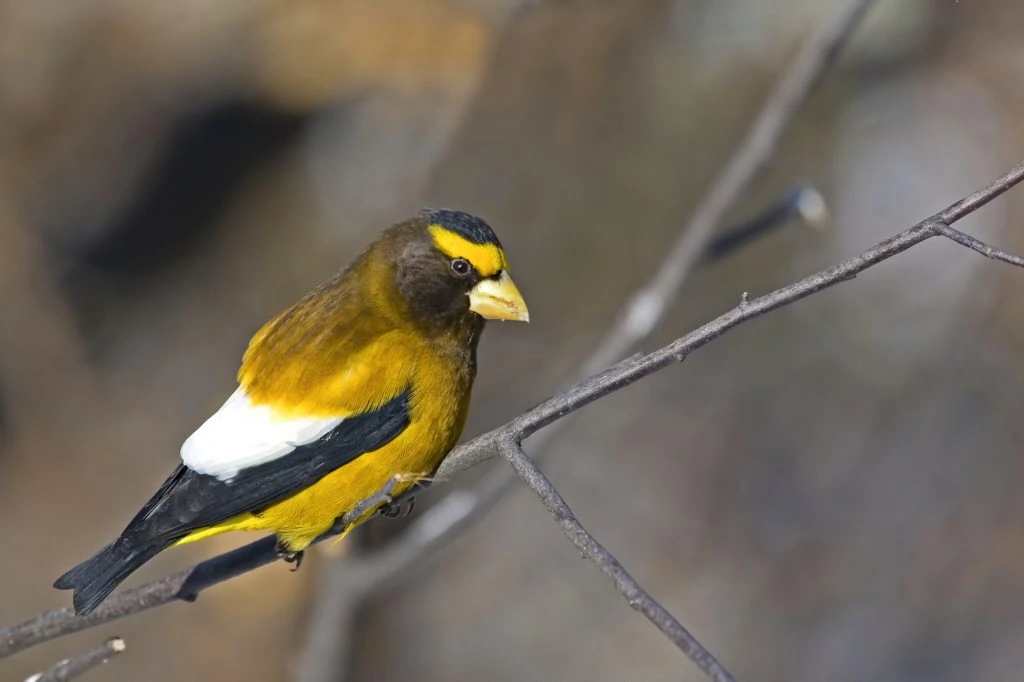
Evening Grosbeaks are vulnerable species in Ontario, and although some can be spotted here all year, they are more common during winter. They occur in 2% of winter checklists.
Evening Grosbeaks are chunky birds with big bills and a striking yellow and black pattern. Adult males have a bright yellow stripe over their eyes, making them look fierce. Their heads are black, with gray necks, and their chest and belly are yellow. They also have a white patch on their wings.
Females and juvenile males have greenish bills, mostly gray bodies, black and white wings, and a yellow tinge to the neck.
- Hesperiphona vespertina
- Length: 16 to 22 cm (6.3 to 8.7 in)
- Weight: 38.7 to 86.1 g (1.37 to 3.04 oz)
- Wingspan: 30 to 36 cm (12 to 14 in)
Evening Grosbeaks remain all year in southern Canada and down the west coast to northern California. However, when cone crops are poor, they will migrate south to most US states.
You can find Evening Grosbeaks in forests and mountain regions. During the winter, they’re often attracted to bird feeders in backyards, most often because it’s an easy food supply.
Evening Grosbeaks naturally feed on flower buds during spring; insect larvae from treetops during the summer; and in the winter, they flock to backyard feeders or feast on seeds, berries, and small fruit.
Evening Grosbeak Song:
Nests of Evening Grosbeaks are usually found up to 100 feet above ground in pine trees. The nests are loosely made, composed of twigs, rootlets, grass, moss, and pine needles. There are usually up to five eggs laid by the female, and she incubates them for two weeks until they hatch.
Attract Evening Grosbeaks to your backyard during winter with sunflower seeds, berries, and maple buds.
Fun Fact: Evening Grosbeaks have such powerful bills that they can crush seeds that are too hard to open for other smaller birds, so these birds hang around to eat whatever is left behind.
7. Pine Grosbeak
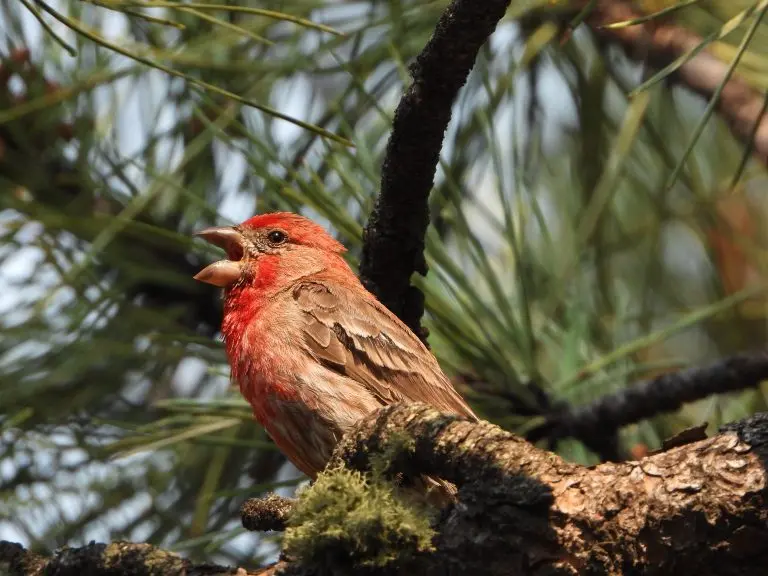
Pine Grosbeaks are winter birds in Ontario and are mainly from November to March. They are recorded in 3% of winter checklists. However, a few can be spotted breeding in the north of the province.
Pine Grosbeaks males are red birds with gray on the wings and tail and two white wingbars. Females are gray with dull orange heads and rumps. They are large for finches and relatively slow.
- Pinicola enucleator
- Length: 7.9-9.8 in (20-25 cm)
- Weight: 2.01 oz (57 g)
- Wingspan: 13.0 in (33 cm)
Pine Grosbeaks are mostly found in Canada, but some can be spotted along the US border, the mountainous west, and the Sierra Nevada in California.
You can find Pine Grosbeaks in forests of pine, spruce, and fir, feeding on seeds, fruit, and buds from these trees. They will also eat some insects in the summer.
Pine Grosbeak Call:
Nests of Pine Grosbeaks are commonly found ten to twelve feet above the ground on a low tree. The nests are made of twigs, barks, weeds, moss, and lichen and hold two to five eggs. The female incubates these eggs for about two weeks until they hatch.
Attract Pine Grosbeaks to your backyards with black oil sunflower seed feeders or suet feeders.
Fun Fact: Pine Grosbeaks are aptly named. Their scientific name, “Pinicola,” is Latin for “pine dweller.”
8. White-winged Crossbill
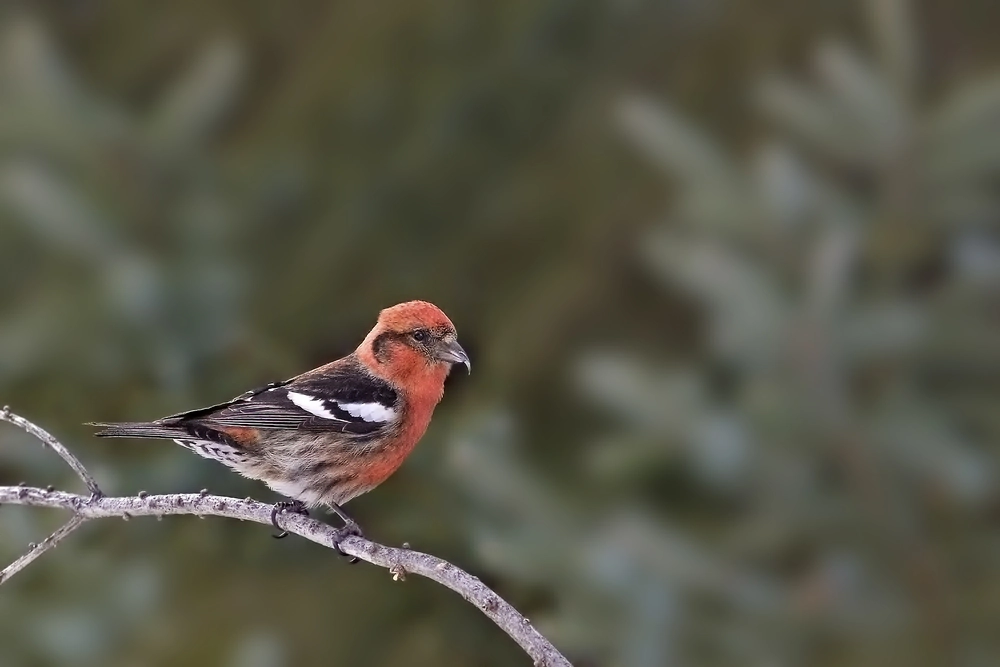
White-winged Crossbills spend the breeding season in northern Ontario and winter in the south of the province. Some also stay all year in some areas.
White-winged Crossbills are finches with heavy crossed beaks. Males are red birds with black wings and tails and two white wingbars. Females are yellow and brown and with two white wing bars.
- Loxia leucoptera
- Length: 5.9-6.7 in (15-17 cm)
- Weight: 0.8-0.9 oz (24-26 g)
- Wingspan: 10.2-11.0 in (26-28 cm)
White-winged Crossbills live in forests in Canada, Alaska, and sometimes the northern US states when cone crops are poor further north.
You can find White-winged crossbills in spruce forests feeding on seeds.
White-winged Crossbill Song:
Nests of White-winged Crossbills are nestled in horizontal tree branches. They are made of twigs, bark, grass, moss, and lichens. There are as many as five eggs in a nest, with the female incubating them for two weeks until they hatch.
Fun Fact: Unusually, these birds breed at any time of year as long as there is enough food. They can often be heard in large flocks.
9. Hoary Redpoll
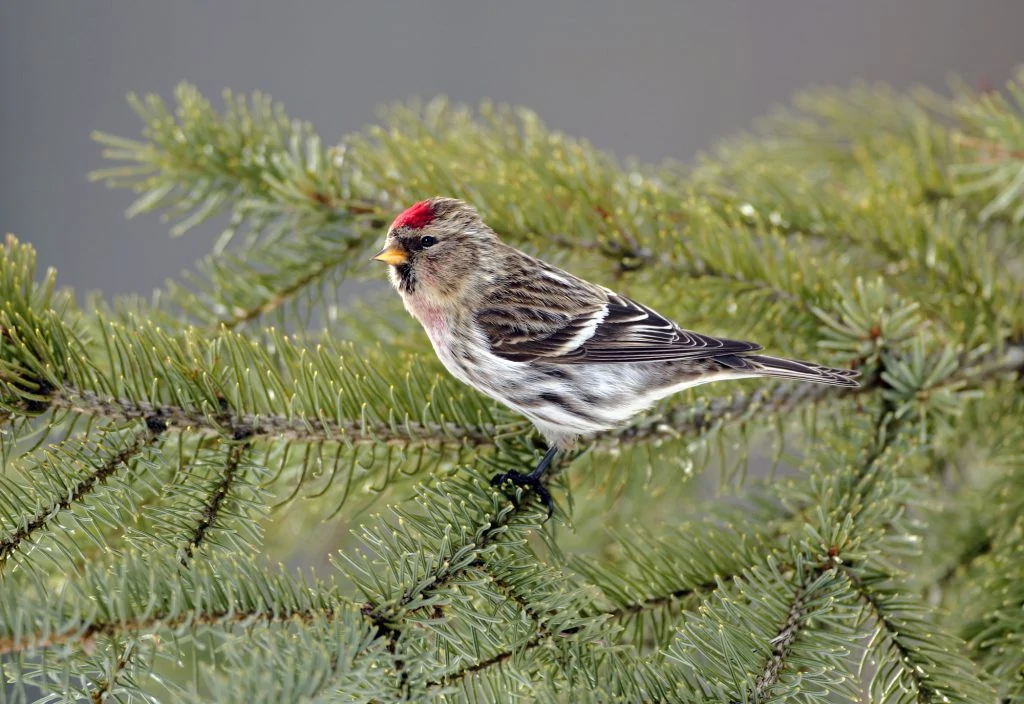
Hoary Redpolls are winter birds in Ontario and can mainly be spotted from December to mid-April in the south of the province.
Hoary Redpolls are small and hardy birds. Adults are generally white and have a red patch on their foreheads. Adult males have a pinkish chest while adult females don’t.
Females do have more streaks on their bellies compared to males. Juveniles look entirely different, having no red patch on their forehead and are mostly gray with a lot of streaking on their body.
- Acanthis hornemanni
- Length: 4.7-5.5 in (12-14 cm)
- Weight: 0.4-0.7 oz (11-20 g)
- Wingspan: 8.5-9.25 in (22-23 cm)
Hoary Redpolls breed in the arctic and move short distances south in winter.
You can find Hoary Redpolls in sheltered tundra birch forests and open subarctic evergreen forests in the summer. Winters bring them closer to towns and villages, in open woodland, scrub, and weedy fields. They feed on seeds of alder and birch trees and on insects.
Hoary Redpoll Song:
Nests of Hoary Redpoll are hidden in the hollows of trees, crevices of rocky areas, and within dense shrubs. The nest is made from twigs, grass, and rootlets and cushioned with soft grass feathers and animal hair. They lay around five eggs which take around ten days to hatch. The young leave the nest in about two weeks.
Fun Fact: If the temperature in their environment becomes too warm, Hoary Redpoll may pluck out some of its body feathers. Don’t worry, they grow back.
10. Red Crossbill
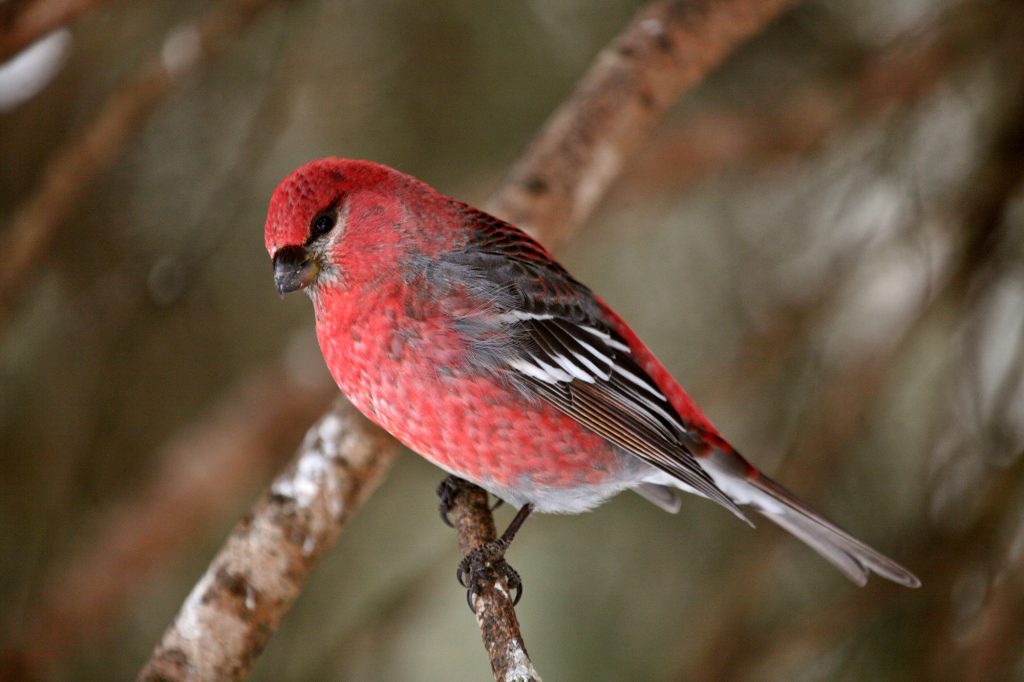
Red Crossbills are not very common in Ontario, but there have been recorded sightings here, mainly during winter in the south of the province.
Red Crossbill males are red birds with darker wings and tails. Females are yellow and brown. Their beaks are an unusual twisted shape that crosses when closed. They have notched tails. Juveniles are browner in color.
- Loxia curvirostra
- Length: 5.5-6.5 in (14-17 cm)
- Weight: 1.4 oz (40 g)
- Wingspan: 10-10.75 in (25-27 cm)
Red Crossbills live year-round in northern and western states and winter in eastern states if cone crops are poor.
You can find Red Crossbills mainly in coniferous forests but also along roadsides consuming grit in the mornings. They feed on conifer seeds and forage in flocks from tree to tree, even breaking unopened cones with their powerful beaks.
Red Crossbill Song:
Nests of Red Crossbills are found near the end of a pine tree. They are shallow saucers made of bark, grass, and roots and lined with moss and plants. The female lays three to four eggs that take as long as eighteen days to hatch.
Attract Red Crossbills to your backyards with Safflower, Apple Slices, Suet, Millet, Peanut Kernels, and fruits.
Fun Fact: Red Crossbills have different types of beaks and utter different flight calls. Birds with the same type of crossbill flock together and recognize each other’s flight calls.
11. Brambling
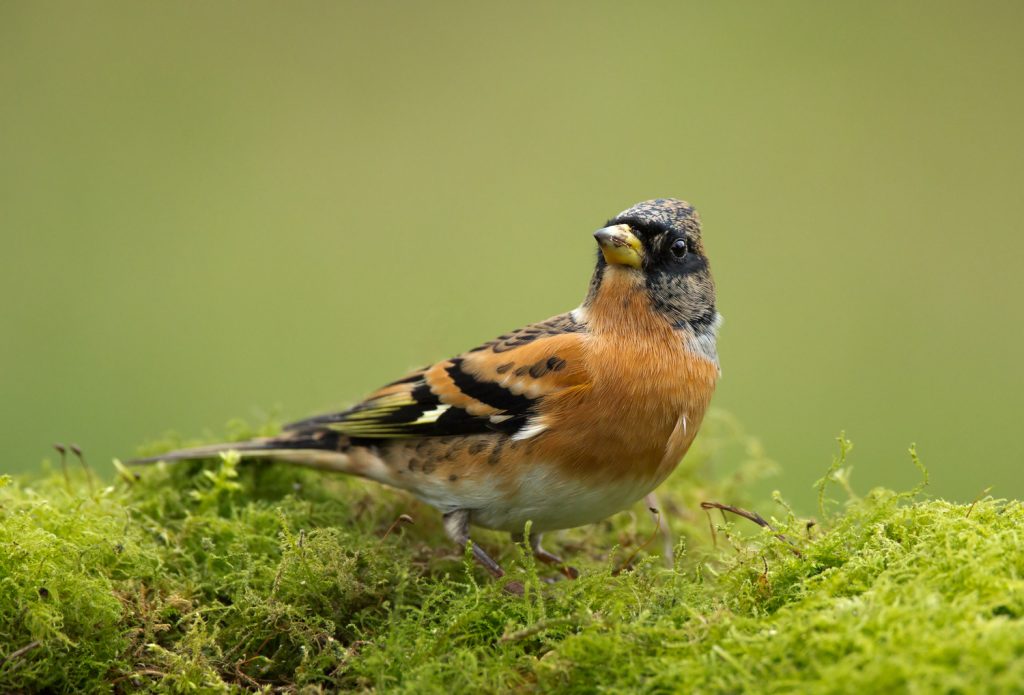
Bramblings are considered rare or accidental species in Ontario that have occasionally been spotted here during winter.
Bramblings are small birds with black heads and orange throats and chests. They have black wings with some white and orange bars. Their bellies are white. Females are less distinct and share the same patterns as juveniles, except that their head is orange.
- Fringilla montifringilla
- Length: 6.3 in (16 cm)
- Weight: 0.81-1.02 oz (23-29 g)
- Wingspan: 9.8-10.2 in (25–26 cm)
Bramblings are usually found in northern Europe, Africa, and Asia, but they also wander into Alaska, occasionally Canada, and northern US states during migration.
You can find Bramblings in birch tree woods, willow forests, agricultural fields, parks, and backyards. They feed on insects in the summer and eat seeds during the winter.
Brambling Call:
Nests of Bramblings are usually up in a tree, secured in a forked tree branch. Females build the nest using grass, birch bark, and moss and strengthen it with spider webs, wool, and down feathers. There may be up to seven eggs at a time, and they take almost two weeks to hatch.
Fun Fact: In winter, bramblings form flocks in the thousands, maybe even millions, but only in their usual winter regions.
12. Gray-crowned Rosy-Finch
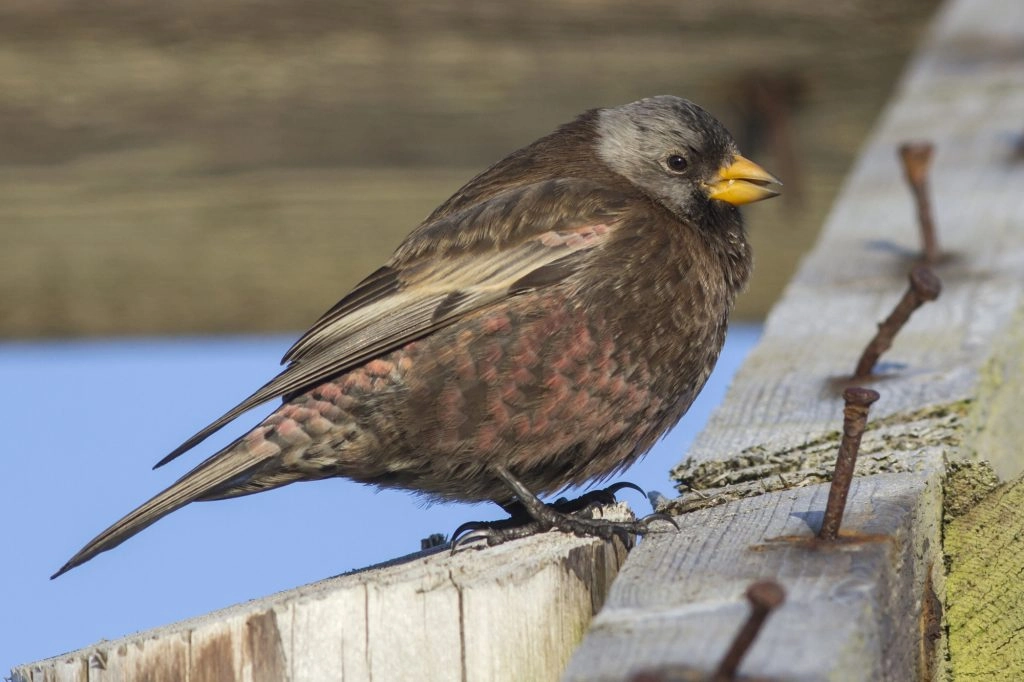
Gray-crowned Rosy-Finches are considered rare or accidental species in Ontario, and they were last spotted here in 2021.
Gray-crowned Rosy-Finches are medium-sized, chunky birds. Adults are identifiable by their black forehead and throat, gray crown, and brown body with pink highlights in their bellies.
In winter, their bill is yellow, then turns black during the breeding season. Juveniles are brown with none of the pink highlights.
- Leucosticte tephrocotis
- Length: 5.5-8.3 in (14-21 cm)
- Weight: 0.8-2.1 oz (22-60 g)
- Wingspan: 13.0 in (33 cm)
Gray-crowned Rosy-Finch breed in Alaska and western Canada before migrating to western US states in winter.
You can find Gray-crowned Rosy-Finch in alpine snowfields, barren tundra, and on rocky islands in summer. In winter, they descend into open plains, valleys, and towns, especially when there are bird feeders.
Gray-crowned Rosy-Finch forage for worms and insects that are frozen in snowfields, glaciers, and meadows during the summer. In the winter, they eat mustard and sunflower seeds and weeds.
Gray-crowned Rosy-finch Call:
Nests of Gray-crowned Rosy-Finch are usually found hidden away in crevices between boulders and cliffs, under a rock, or even in mine shafts and holes in abandoned buildings.
Their nests are made from grass, roots, moss, and sedge and lined with fine grass, animal hair, and feathers. The female usually lays around four eggs which hatch after two weeks, and the young are ready to leave the nest after another two weeks.
Attract Gray-crowned Rosy-Finches to your backyard by feeding them black oil sunflower seeds. You can scatter the seeds on the ground or platform feeders.
Fun Fact: Gray-crowned Rosy-Finches will probably win the award for “Highest Altitude Breeding Bird in North America” since they nest on the slopes of Denali, known for being the continent’s highest peak.
13. Cassin’s Finch
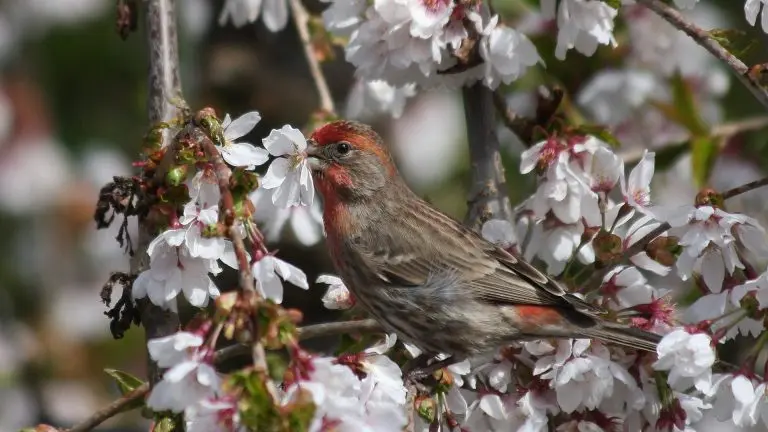
Cassin’s Finches are accidental species in Ontario, and they have only been spotted here a few times, but not for many years.
Cassin’s Finch males have a red crown, rosy pink head, and red-breasted with a whiteish belly and brown back and wings. Females and juveniles are brown-streaked all over.
- Haemorhous cassinii
- Length: 6.3 in (16 cm)
- Weight: 0.8-1.2 oz (24-34 g)
- Wingspan: 9.8-10.6 in (25-27 cm)
Cassin’s Finches live all year in mountain forests in western US states and into southwestern Canada. Some migrate into northern Mexico in winter.
You can find Cassin’s Finches foraging in flocks for seeds in conifer forests. They also eat quaking aspen buds, berries, and other fruit, and some insects such as moths.
Cassin’s Finch:
Nests of Cassin’s Finches are usually built on pine or similar trees. The nests are cup-like and made of twigs, barks, reeds, and rootlets. A nest can hold four to six eggs which are incubated by the female for about two weeks.
Attract Cassin’s Finches to your backyards with sunflower seed feeders, especially in winter, or fruiting shrubs such as cotoneaster, mulberries, firethorn, grape, and apple.
Fun Fact: The male Cassin’s Finch may confuse you. During its first breeding season, it retains its female-like feather coloring and sings, giving you the impression that females also sing.
14. Lesser Goldfinch
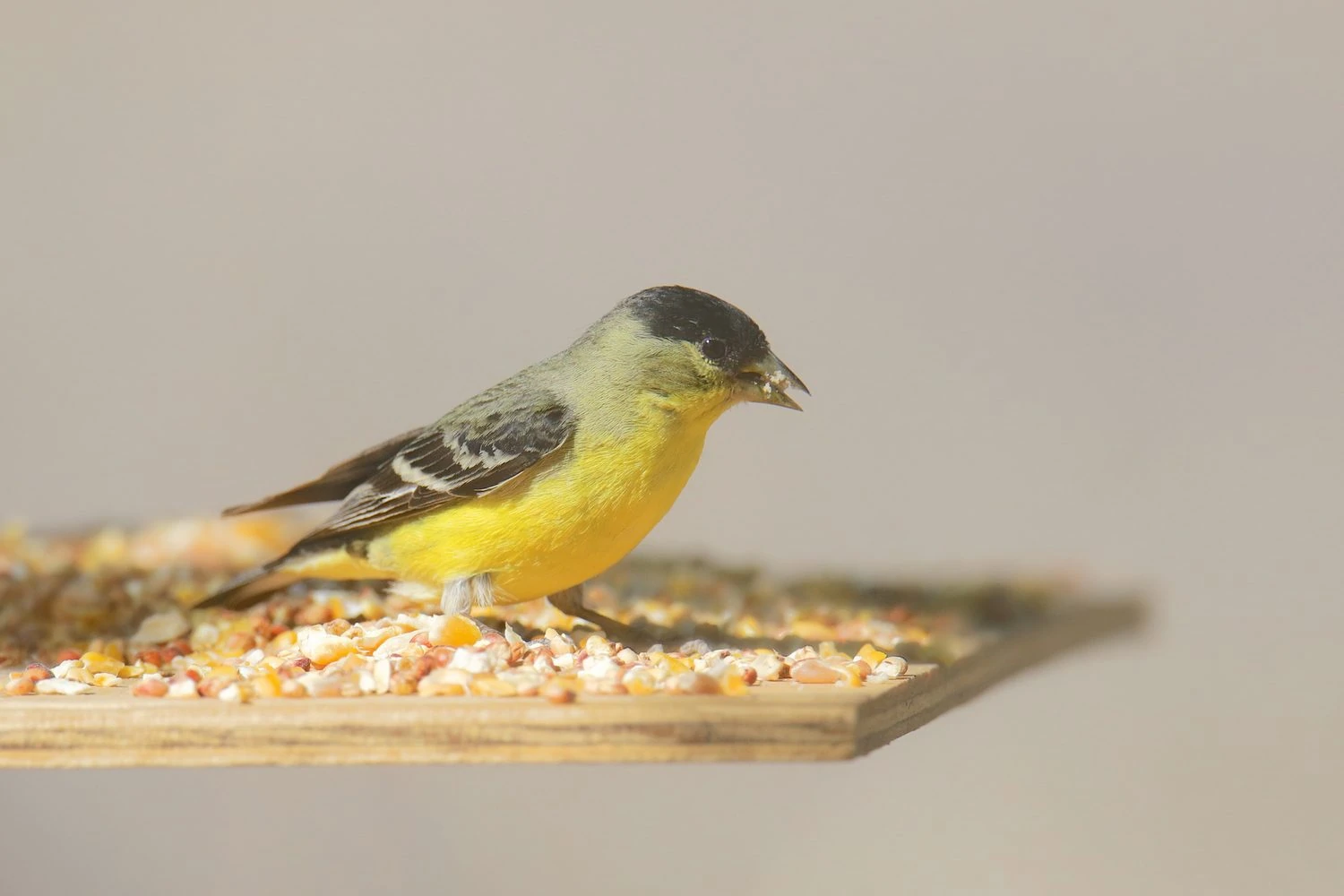
Lesser Goldfinches are accidental species in Ontario, and they have only been spotted here around Toronto but not for many years.
Lesser Goldfinches are tiny bright yellow and black songbirds with long pointed wings and short notched tails. Females have olive backs and are more dull yellow underneath.
- Spinus psaltria
- Length: 3.5-4.3 in (9-11 cm)
- Weight: 0.3-0.4 oz (8-11.5 g)
- Wingspan: 5.9-7.9 in (15-20 cm)
Lesser Goldfinches live in the southwestern US states and the West Coast all year, but those that breed in the interior of western US states migrate for winter.
You can find Lesser Goldfinches in large flocks in open habitats, including thickets, weedy fields, forest clearings, parks, and gardens. They forage for seeds, especially sunflower seeds, but also fruits from elderberry, coffeeberry, and buds from cottonwoods, willows, sycamores, and alders.
Lesser Goldfinch call/Song:
Nests of Lesser Goldfinches are built in a tree or a low bush. The female uses twigs, barks, leaves, and rootlets to make the nest for her three to six eggs. She will incubate them for as long as twelve days until they hatch.
Attract Lesser Goldfinches to your backyards with sunflower seeds and nyjer in tube feeders or platform feeders.
Fun Fact: The Lesser Goldfinch is named as such because it’s the smallest Goldfinch.
How Frequently Finches are Spotted in Ontario in Summer and Winter
Checklists are a great resource to find out which birds are commonly spotted. These lists show which Finches are most frequently recorded on checklists on ebird in summer and winter.
Finches In Ontario in Summer:
American Goldfinch 44.7%
House Finch 8.8%
Purple Finch 6.0%
Pine Siskin 2.6%
Evening Grosbeak 0.9%
White-winged Crossbill 0.3%
Common Redpoll 0.2%
Red Crossbill 0.2%
Pine Grosbeak <0.1%
Hoary Redpoll <0.1%
Gray-crowned Rosy-Finch <0.1%
Cassin’s Finch <0.1%
Finches In Ontario in Winter:
American Goldfinch 27.9%
House Finch 12.0%
Common Redpoll 8.5%
Pine Siskin 3.8%
Pine Grosbeak 3.2%
Purple Finch 2.3%
Evening Grosbeak 2.2%
White-winged Crossbill 0.9%
Hoary Redpoll 0.9%
Red Crossbill 0.4%
Gray-crowned Rosy-Finch <0.1%
Brambling <0.1%

